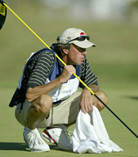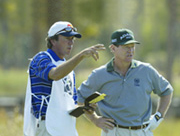 |
 |
 |
| |
|
|
| In the last 16 months of his life, Bruce Edwards staged a public fight against ALS. After his diagnosis, Bruce continued to work as a professional Tour caddy, carrying a 50-pound golf bag 18 holes a day, week after week. Wherever he went, the galleries cheered for Bruce as much as for Tom. Although the disease was sapping him of his ability to speak and weakening his muscles, he continued doing what he loved best…caddying for Tom Watson on the PGA Tour. |
Though ALS diminished Bruce physically, it couldn’t affect his love
for his job, his relationship with Tom or his eternal optimism that he would help find treatments and a cure for the disease. Upon his
diagnosis at the Mayo Clinic in January 2003, he called Tom and told
him “I got a quad,” as in a quadruple bogey. From that day forward, Bruce reluctantly put his low profile behind him, and became a public figure in the fight against the disease.
Making Caddying a Career |
 |
|
Becoming a public figure was never in Bruce’s game plan. Since his first event as a regular caddy on the PGA Tour, the 1973 Kemper Open, Bruce’s goal was to be the very best at his job…behind the scenes motivating his player, knowing yardages for every hole on every course, reading putts, helping select clubs. In more than 30 years on the PGA and Champions Tours, he accomplished this and more. |
He became one of the Tour’s most influential caddies and helped make the craft respectable. It was a career, not a hobby, and he approached his work with a legendary attention to detail. Often mistaken for one of the professional golfers, Bruce always dressed well and was never late for a tee time for a practice or competitive round. He knew how to keep his player pumped, when to give positive feedback or, as Watson said, when to give his player “a kick in the butt.”
He could tell what the wind direction on a specific hole on a specific course in the most specific weather conditions would do to a tee shot. He walked every course before each tournament, marking yardages and pin placements. He kept all his yardage books for years, but double-checked the measurements at every tournament, never relying on someone else to tell him about course changes. |
 |
Anyone who knew Bruce growing up in Wethersfield, CT, was sure he would go on to a career in golf. Once bitten by the caddy bug at Wethersfield Country Club (where he caddied for golfer Dick Lotz in many Greater Hartford Opens), Bruce was determined to make his living at it. |
|
Thirty-four people graduated from Marianapolis Prep School in 1973, and thirty-three headed off for college. Bruce headed for Charlotte, NC and picked up a job with David Graham at the Kemper Open. Even after being told by Graham that week that he was “too nice a kid” to caddy full-time, Bruce continued his quest. Just six weeks into his new life on the tour, he met a “long haired golfer” in the parking lot at the St. Louis Classic, and a historic friendship was born.
A Life of Accomplishment
While most golfer/caddy relationships average five years, Bruce and Tom lasted more than 30. Though he left Tom for three years in 1989 to caddy for Greg Norman (with Tom’s blessing and encouragement) he returned to Watson in 1992. Bruce was with Tom for 35 Tour wins, including the 1982 U.S. Open at Pebble Beach, where Tom chipped in on the 17th hole to secure the victory. He was named by Captain Ben Crenshaw as a special assistant to the 1999 Ryder Cup team, in charge of the U.S. caddies. |
| On October 20, 2003, Bruce was inducted in the Professional Caddies Association “Caddie Hall of Fame” at the World Golf Village. Bruce accepted his honor with a typically humble response: “I never believed caddies should be in a hall of fame. It’s supposed to be a low-profile job. The only thing that’s important is that I do a good job. But…I’m
flattered and honored." |
 |
|
His last honor was receiving the 2004 Ben Hogan Award, given annually to an individual who has continued to be active in golf despite a physical handicap or serious illness. The award was presented to Bruce’s father on April 7, 2004, and after the ceremony, several of his friends called Bruce at home to laugh and tell stories about the evening’s festivities. Bruce died hours later at his home in Ponte Vedra Beach, Florida, with his wife Marsha at his bedside.
In June of 2003, Bruce looked back on his career and his life with no regrets. “If I go in a year or less,” he said, “I’ve had a wonderful life. I’ve been lucky. I’ve had a wonderful ride, a lot of wins, a lot of great moments.”
As Bruce himself put it, “All you can do is decide to live each day and carry on.” Tom has made it his mission to continue Bruce’s fight, raising money for ALS research in hope of finding a cure so others can carry on as well.
|
|
|
|
|
|
 |
 |
 |
|